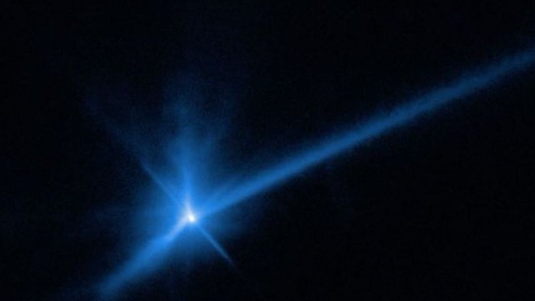Thomas Zurbuchen, former Associate Administrator of NASA’s Science Mission Directorate: “The debris from DART’s impact could potentially create a unique meteor shower, providing a new opportunity to study interplanetary material that was once an asteroid” (Reuters).
Professor Alan Fitzsimmons, Astrophysicist at Queen’s University Belfast: “It’s an exciting prospect that humanity’s attempt at planetary defense could also create a new meteor shower visible from Earth” (The Guardian).
NASA’s Double Asteroid Redirection Test (DART) mission, which deliberately crashed a spacecraft into the asteroid Dimorphos in 2022, may lead to the first human-made meteor shower, known as the Dimorphids. The primary goal of the DART mission was to test asteroid deflection technology as a measure for planetary defense. By crashing a spacecraft into an asteroid at 13,645 miles per hour (6.1 kilometers per second), NASA aimed to determine if such a kinetic impact could alter the asteroid’s trajectory.
#FPExplained: NASA’s DART mission, which successfully altered the orbit of the asteroid Dimorphos in 2022, might also lead to an extraordinary phenomenon: the first human-made meteor shower, dubbed the Dimorphids.
What was the mission about?https://t.co/7I98zX51Ff
— Firstpost (@firstpost) September 2, 2024
Dimorphos, a small asteroid orbiting a larger space rock named Didymos, was selected as the ideal target for this experiment. Neither of these celestial bodies pose a threat to Earth, but Dimorphos is comparable in size to asteroids that could potentially endanger our planet.
Since the impact, astronomers have been monitoring the aftermath using ground-based telescopes. They confirmed that the DART mission successfully altered Dimorphos’s orbital period around Didymos by 32 to 33 minutes. However, the collision also produced over 2 million pounds (nearly 1 million kilograms) of debris, creating a cloud of rocks and dust, and raising questions about where this material will end up.
Recent research indicates that fragments from Dimorphos could reach Earth and Mars in the next few decades, with some debris potentially arriving at Mars within seven years and Earth’s atmosphere within ten. The study, published in the Planetary Science Journal, suggests that this debris could create visible meteors or “shooting stars” as it enters the Martian atmosphere, continuing intermittently for up to 100 years.
Dr. Mark Boslough, Impact Physicist: “This could be a spectacular event for scientists and sky-watchers alike, allowing us to observe and learn from a controlled impact” (Space.com).
While the debris is expected to range from tiny particles to pieces the size of smartphones, none of it is likely to pose a risk to Earth. The particles would burn up in Earth’s atmosphere due to the process of ablation, which occurs when friction with the air causes high-speed objects to disintegrate.
To predict the debris’s path, researchers used data from LICIACube, a small satellite that separated from the DART spacecraft before impact to capture detailed footage of the collision and the resulting debris cloud. Using supercomputing resources, they simulated the trajectories of 3 million particles created by the impact, factoring in the sun’s radiation and other variables.
The study confirmed that debris moving at slower speeds could reach Mars, while faster fragments could reach Earth within a decade. Though the prospect of a Dimorphids meteor shower reaching Earth is unlikely, it cannot be entirely ruled out. If it does occur, the meteor shower would likely be faint and visible primarily from the southern hemisphere.
NASA’s DART mission could trigger man-made meteor shower: What you need to know https://t.co/wjbyF44JDL
— chandra kumar h s Ediga kannada (@chandrakumarhs) September 2, 2024
The possibility of the debris impacting nearby asteroids was also suggested, though this was not the primary focus of the study. Future observations, including those planned for the European Space Agency’s Hera mission set to launch in October, will help refine these predictions. The Hera mission aims to closely examine the debris and Dimorphos to determine the extent of the asteroid’s transformation and the momentum transferred from the DART spacecraft.
This ongoing research could provide significant insights into the dynamics of asteroid systems and the potential risks and benefits of using kinetic impacts for planetary defense.
Key Points:
i. NASA’s DART mission, which crashed into the asteroid Dimorphos, could create the first human-made meteor shower, named the Dimorphids.
ii. mission successfully altered Dimorphos’s orbit, producing over 2 million pounds of debris, some of which could reach Earth and Mars in the coming decades.
iii. While the debris is expected to burn up in Earth’s atmosphere, scientists are studying its potential paths using data from a satellite that recorded the collision.
iv. A future meteor shower from the debris reaching Earth is considered unlikely but not impossible.
v. Further observations, including a mission set to launch in October, aim to refine predictions about the debris and its potential impacts.
Kirk Volo – Reprinted with permission of Whatfinger News



